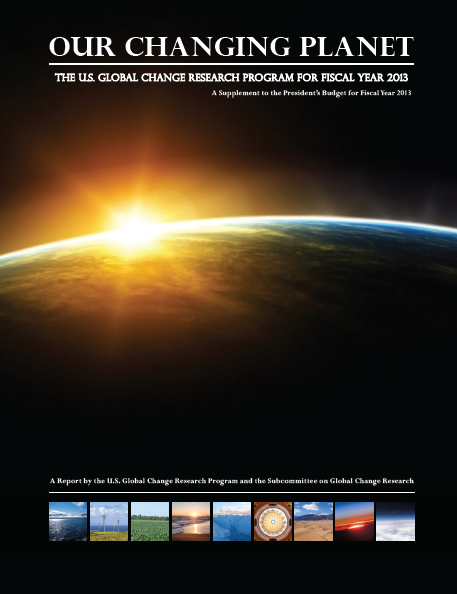
 Today, the Administration’s interagency U.S. Global Change Research Program (USGCRP) delivered its annual report to Congress for fiscal year 2013: “Our Changing Planet.” The report highlights recent activities by 13 Federal agencies to strengthen our scientific understanding of global changes—including climate change—the threats and opportunities they present, and how they are likely to evolve over time.
Today, the Administration’s interagency U.S. Global Change Research Program (USGCRP) delivered its annual report to Congress for fiscal year 2013: “Our Changing Planet.” The report highlights recent activities by 13 Federal agencies to strengthen our scientific understanding of global changes—including climate change—the threats and opportunities they present, and how they are likely to evolve over time.
USGCRP’s scientific portfolio spans multiple systems and scales, from organisms to ecosystems to the entire planet—including changes brought about by human behavior as well as by larger natural forces. It incorporates information from nearly all forms of scientific work, including laboratory experiments, field research, computer modeling, scientific assessment, and observations of Earth from land, air, sea, and space. This vast body of work has been carried out by 13 government agencies—all working together to paint a clearer picture of global change so that citizens and decision makers have the information they need to plan, prepare, and respond.
Indeed, the benefits of this work extend far beyond pure science into domains that are directly relevant to the day-to-day lives of Americans and others around the world. They support weather forecasting, water and land resource management, agricultural crop production, and many other functions that impact lives, livelihoods, and communities.
The Our Changing Planet report released today showcases tangible results of work carried out by USGCRP agencies, including, for example, some of the most detailed, data-rich maps of Alaskan permafrost ever generated; the most precise map ever produced of carbon stored in Earth’s tropical forests; critical information about the number and magnitude of extreme weather events in the United States; and updated maps that help gardeners and growers plan for harvesting seasons.
USGCRP has supported these kinds of advances for more than two decades in fulfillment of its Congressional mandate to “understand, assess, predict, and respond to human-induced and natural processes of global change.”
Building on 20 years of scientific experience, USGCRP scientists continue to expand our knowledge of Earth’s past and present climate, improve projections of future climate change, and achieve a better understanding of the impacts and risks associated with global change—all with the aim of getting practical information, useful tools, and reliable data into the hands of those who need it.
I encourage you to learn more about USGCRP’s significant scientific contributions and how they benefit the Nation by reading this year's Our Changing Planet report.
Tom Armstrong is Executive Director of the US Global Change Research Program

